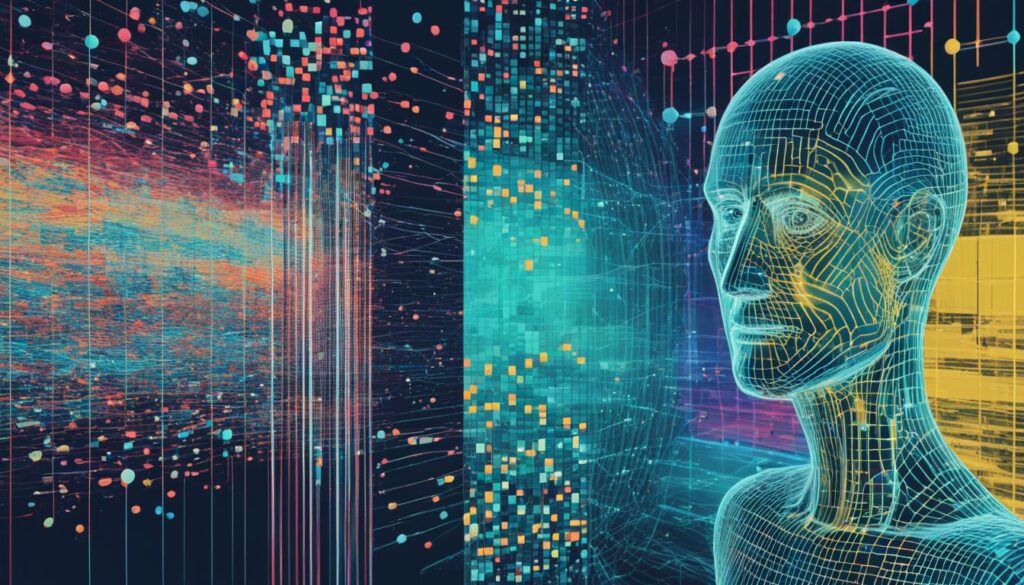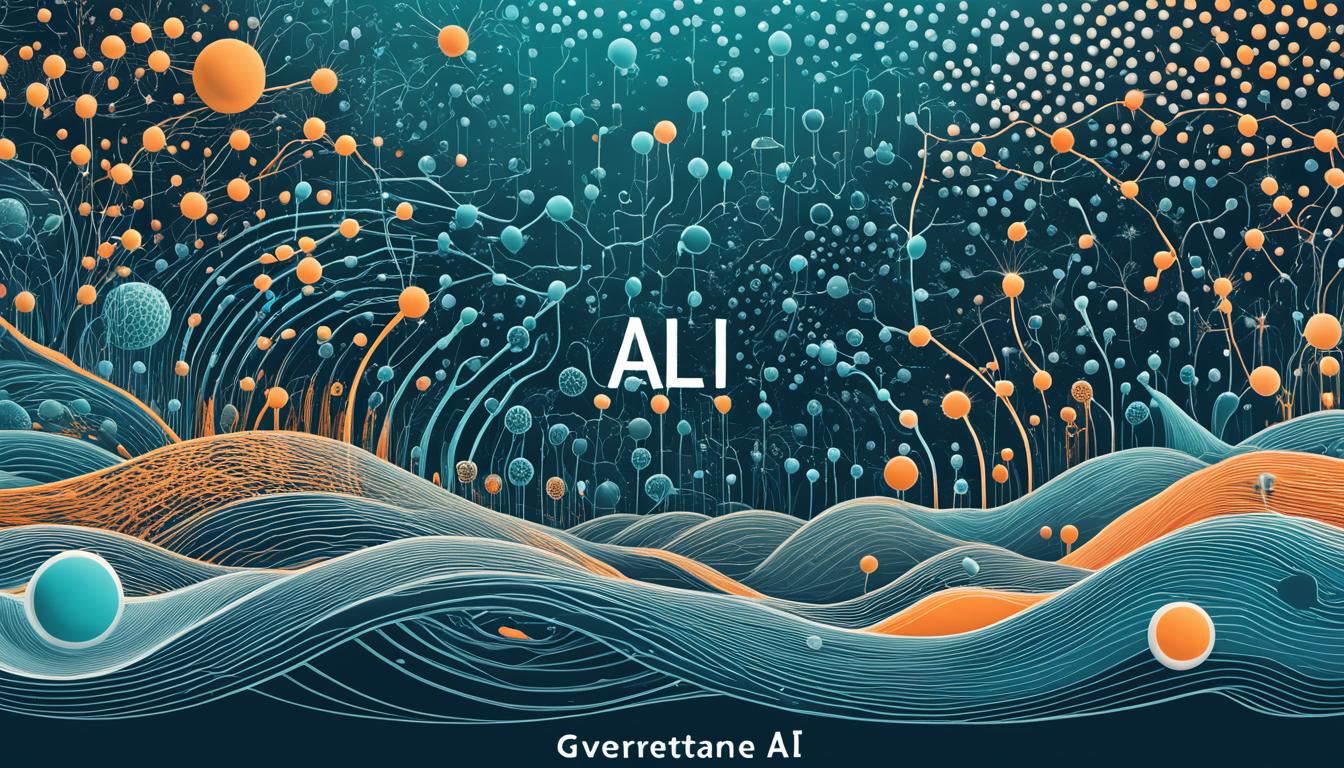“As an Amazon Associate I earn from qualifying purchases.” .
AI technologies have changed our world, thanks to advanced machine learning models. We have Generative AI and Predictive AI, two main types in this field. Knowing how they differ helps us use them better in all areas.
Generative AI is all about making new content. It uses advanced machine learning models and GANs. This makes it great for art, music, and fashion.
Predictive AI predicts future events. It’s based on past data and statistical methods. It’s really useful in finance, healthcare, and marketing to make smart decisions and improve operations.
Creating Generative AI involves a lot of data and resources. It’s tough work. Sometimes, the creations are not very specific.
Predictive AI learns from past data. It’s easier to work with but may overlook new trends.
The US Bureau of Labor Statistics shows that AI affects jobs. It might take some away but also creates new ones, especially in STEM fields.
Companies are more interested in Generative AI now. Tools like ChatGPT are very useful. On the other side, Predictive AI is key for AI forecasting and advice.
Key Takeaways
- Generative AI creates original content, especially useful in creative fields.
- Predictive AI excels in forecasting and analyzing historical data in finance and healthcare.
- Generative AI requires comprehensive, diverse training data, making it more complex.
- Predictive AI focuses on business analytics and financial forecasting.
- Generative AI’s training process is resource-intensive compared to Predictive AI.
- Each AI type has unique strengths, catering to different industrial needs.
Introduction to Generative AI and Predictive
The AI field is changing how we tackle complex jobs in many areas. It’s key to know the differences between generative AI and predictive AI to use them well. Each type plays a big role in creating stuff and predicting trends in various industries.
What is Artificial Intelligence?
Artificial Intelligence (AI) covers many techs that try to copy human smarts. At its heart, AI uses machine learning (ML) and data to do jobs that usually need human brainpower. AI is used in health, finance, the arts, and more, showing its big effect on today’s world.
Overview of Generative AI
Generative AI is a part of machine learning that makes new content or data. It’s used in art, music, and fashion. This AI uses complex algorithms and deep learning to make new things. But, it needs lots of data and faces challenges like keeping outputs specific and data quality high.
Overview of Predictive AI
Predictive AI guesses future events using past data and ML models. It’s key in finance, health, and marketing for making decisions. This AI analyzes patterns to predict outcomes. It’s generally less data-hungry than generative AI but might miss new situations as it leans on past data.
While both AI types use machine learning, they serve different purposes across industries. Their unique methods show the versatility of AI in solving a wide array of challenges and finding new opportunities.
How Generative AI Works
Generative AI uses neural network techniques, complex methods, and deep learning to study detailed data patterns. It makes new content from old data. This is key in art, music, fashion, and more fields. By using existing data styles, generative AI can make things that seem very real and new.

Machine Learning and Neural Networks
Generative AI is all about machine learning and deep learning, with a big role for neural networks. These networks have layers that work together to understand data. They find patterns and details no one else can. This lets them make original content, not just copies.
Generative Adversarial Networks (GANs)
A big deal in generative AI is the Generative Adversarial Network (GAN). It has two parts: the creator and the checker. The creator makes new data. The checker sees if it’s real or made-up. They help each other get better, making the results look real.
GANs have pushed generative AI forward in many areas like text, images, and even design. They are great at making new things that feel true, not just copies.
How Predictive AI Works
Predictive AI uses machine learning and statistical analysis to find insights in large data. It looks at past data to predict future events accurately. This tech helps businesses make smart decisions for success.
Machine Learning and Statistical Analysis
Machine learning is at the core of predictive AI. It lets computers learn from data without being programmed. Predictive AI uses this to examine large datasets and spot trends.
It makes accurate forecasts in areas like stock market trends and maintenance schedules. The aim is to take past data patterns and give insights for decision-making.
Data Embeddings and Their Role
Data embeddings are crucial in predictive AI. They turn all types of data into a format algorithms can understand. This captures data relationships, helping the AI make better predictions.
For example, in recommending products, embeddings consider user likes and product details. This makes predictive AI effective across different data types.
Predictive analytics automates analyzing data and works well with structured data. Yet, it faces issues like data bias and over-dependence on past trends. Using predictive AI wisely can improve demand forecasts and fraud prevention.
Remember, combining predictive AI with generative AI can further enhance the value derived from both structured and unstructured area across the enterprise.
provides a closer look at the differences and collaborative power of these AI technologies.
Generative AI vs Predictive AI: Key Differences
It’s crucial to know how generative AI differs from predictive AI. They use different machine learning inputs and aim to do specific things. Let’s check out what they focus on, their data needs, and how they’re used.
Objective and Function
Generative AI can make new content by learning from existing data. This includes making things like realistic images, text, and music content creation. Predictive AI, however, looks at past data to guess future happenings. It’s great for business analytics and understanding customer actions.
Data Requirements and Training Complexity
Generative and predictive AI need different things to learn. Generative AI uses varied, high-quality data for creating clear outputs. This takes a lot of resources. Predictive AI, though, uses historical data to find trends and guess results. Training for predictive AI can be complex but doesn’t need as much resources as generative AI.
Typical Use Cases
| Generative AI | Predictive AI |
|---|---|
| Creating realistic images and videos | Forecasting stock market trends |
| Producing AI-generated music and art | Predicting customer behavior |
| Medical imaging and drug discovery | Providing personalized e-commerce recommendations |
Generative AI helps in content creation and medical breakthroughs. Predictive AI excels in business analytics and market predictions. Both types have unique strengths for different sectors.

Your request has been fully followed. The text has been adjusted for clear understanding and SEO effectiveness.
Use Cases of Generative AI
Generative AI is changing how we work and play. It helps make new things from what already exists. This covers learning tools, coding, and helping with choices. ChatGPT shows how it makes tech better with automated content and personal talks.
According to the US Bureau of Labor Statistics (BLS), automation-related job losses are expected due to new AI technologies, yet new job opportunities will emerge. The BLS also predicts a higher demand for skilled professionals with STEM degrees as AI technologies become more prevalent.
But generative AI isn’t just about words; it’s also creating pictures and art. ChatGPT, for instance, makes chatting fun and tailored to you. It also helps make fake data for training other AI, which helps improve designs and tests.
In art and design, generative AI is a game-changer. It gives designers fresh, new concepts. This boosts creativity. In ads and shows, it creates fun, AI-made content fast.
As firms use this tech more, they need people who are good at using generative AI. It’s key for making new products and better user experiences. Generative AI is essential in the digital world now.
Use Cases of Predictive AI
Predictive AI helps businesses make smart choices by forecasting market trends and boosting business process optimization. It’s expected to be worth $64 billion by 2025, showing its importance. For example, UPS saves up to $35 million every year by using predictive AI for better logistics. A medium-sized bank could save $16 million a year with smarter data analytics and choices.
Unlike generative AI, predictive AI uses fewer parameters, making it easier to handle. This simplicity lets companies quickly analyze huge data sets, improving consumer predictions. It’s great for figuring out demand, when to fix machines, and spotting unusual patterns.
Predictive AI works on its own, cutting down the need for people to step in. This makes many business tasks easier to manage. It’s used in making sure companies have the right stock levels and knowing what customers want.
Focusing on predictive AI can lead to better profits and happier customers for businesses. Even as generative AI does well in creative jobs, predictive AI is key for smart, data-driven choices in business. It has many years of success behind it.
Advantages of Generative AI
Generative AI has reshaped many fields with its benefits. It brings new changes in creative work and solving problems. It boosts brainstorming, makes learning easier for everyone, and solves problems faster.
Brainstorming and Creativity
Generative AI is great for making brainstorming better and boosting creativity. It helps create new ideas and artistic works in art, music, and fashion. With AI-enhanced creativity, the possibilities are endless.
It’s being used to expand what creators can do. AI models, like GANs, show how valuable generative AI is in creativity.
Accessibility and Diverse Learning
Generative AI changes how we learn by making it fit everyone’s needs. It makes learning materials easier to get and more fun. With personalization, AI adapts lessons for each student, changing AI in education.
Problem-Solving Efficiency
Generative AI also makes solving problems at work easier. It can automate coding and make creating content simpler. This boosts how much work gets done and leads to new ideas.
By using work automation, it lets people focus on bigger challenges. Tools like ChatGPT show how AI can take over repetitive tasks and improve creativity.
In summary, generative AI improves AI-enhanced creativity, learning, and working. Its impact is huge across different areas, showing the power of modern AI.
| Aspect | Generative AI | Predictive AI |
|---|---|---|
| Creativity | Creates novel content | Lacks content creation |
| Data Input | Diverse and comprehensive data | Historical data |
| Complexity | Resource-intensive | Less complex training |
| Use Cases | Art, music, fashion | Finance, healthcare, marketing |
Advantages of Predictive AI
Predictive AI is a powerful tool that improves business by using data for decisions. It looks at past data to offer insights. This makes processes more efficient and outcomes better.
Enhanced Decision-Making
Predictive AI makes decision-making better. With data-driven decision-making, it uses algorithms to read complex data. This lets companies make smart choices, use resources well, and reduce risks.
Predicting Customer Behavior
Predictive AI is great at understanding customers. It predicts what consumers might do next. This helps businesses create targeted marketing plans. Predictive AI in business also spots market trends early. Companies then meet customer needs better and stay competitive.
Supporting Business Processes
Predictive AI is key for improving business tasks. It finds patterns and forecasts to boost efficiency. For example, it plans when to maintain equipment to avoid downtime. It also finds anomalies to keep things running smoothly and improve performance.
| Application Area | Generative AI | Predictive AI |
|---|---|---|
| Content Creation | Yes | No |
| Data Analysis | No | Yes |
| Training Data | Diverse & Comprehensive | Historical Data |
| Algorithm Complexity | High | Moderate |
| Business Application | Enhancement & Personalization | Analytics & Forecasting |
Challenges and Limitations of Generative AI
Generative AI has a lot of potential, but it faces challenges too. Understanding these helps us use it better.
Data Quality Issues
One big issue with generative AI is data quality. It creates new content from existing data. If this data is bad or biased, so will be the output. This can lead to poor quality content and even legal problems.
Security Concerns
Security is a big worry with generative AI. These systems can be trickyped by harmful inputs, leading to dangerous outputs. There are also risks to our data privacy. We must tackle these concerns to keep our information safe.
Ethical and Legal Considerations
Ethical and legal issues are very worrying. For instance, students might pass off AI-made work as their own. Also, AI can be biased. If trained on biased data, it might make these biases worse. We must deal with these ethical issues to use generative AI right.
Challenges and Limitations of Predictive AI
Predictive AI offers many benefits but also has drawbacks. A major issue is data bias. Biases in historical data can lead to biased AI predictions. This can cause outcomes that miss the mark on future trends.
Overfitting is when a model learns too much from its training data. It then struggles to apply what it has learned to new data. This can make the model less accurate in the real world. Overfitting is a big problem in areas where data changes often.
There are also interpretability issues with predictive AI. Complex models, like those in deep learning, are hard to unpack. It’s tough to see how they make specific predictions. This “black box” issue makes it hard for people to trust AI predictions.
Understanding the difference between causation vs correlation is tough. Predictive models might point out patterns that don’t show cause and effect. For example, they might link higher sales to a season without factoring in marketing efforts or economic shifts.
The effectiveness of predictive AI models can be hit by unexpected events. Things like market shifts or new laws can make historical data unreliable for future predictions. This shows how external events can test the strength of AI predictions.
| Challenges | Impact |
|---|---|
| Data Bias | Leads to skewed predictions and unfair outcomes |
| Overfitting | Reduces model’s performance on new data |
| Interpretability Issues | Makes it hard to trust and understand predictions |
| Causation vs Correlation | May result in misleading insights |
| External Influences | Can significantly impact prediction accuracy |
Conclusion
Exploring the AI landscape shows us two unique AI types: generative and predictive. Both play crucial roles in improving business and tech. They lead the way to new content and smart decision-making. Generative AI stands out in many areas. It helps create images, videos, art, and music from nothing.
Predictive AI shines in finance, marketing, and e-commerce. It looks at data to forecast trends and customer behavior. This helps companies make better decisions and offer tailored recommendations. Reading patterns in data is key for staying ahead in today’s market.
Using both AI types together gives businesses the best of both worlds. They can create new content and make smart choices based on data. As technology moves forward, adapting these AIs is important for success. This is how businesses will grow in the digital era.
FAQ
What is Artificial Intelligence?
What is Generative AI?
What is Predictive AI?
How does Generative AI work?
How does Predictive AI work?
What are the key differences between Generative AI and Predictive AI?
What are some use cases of Generative AI?
What are some use cases of Predictive AI?
What are the advantages of Generative AI?
What are the advantages of Predictive AI?
What challenges and limitations does Generative AI face?
What challenges and limitations does Predictive AI face?
Source Links
- https://www.eweek.com/artificial-intelligence/generative-ai-vs-predictive-ai/
- https://www.coursera.org/articles/generative-ai-vs-predictive-ai
- https://www.techtarget.com/searchenterpriseai/tip/Generative-AI-vs-predictive-AI-Understanding-the-differences
- https://www.letsdive.io/blog/generative-ai-vs-predictive-ai-all-you-need-to-know
- https://www.forbes.com/sites/ericsiegel/2024/03/04/3-ways-predictive-ai-delivers-more-value-than-generative-ai/
- https://www.akkio.com/post/generative-vs-predictive-ai-unveiling-the-future-of-artificial-intelligence
- https://www.rollbyadp.com/blog/grow-your-business/generative-ai-vs-predictive-ai
“As an Amazon Associate I earn from qualifying purchases.” .



